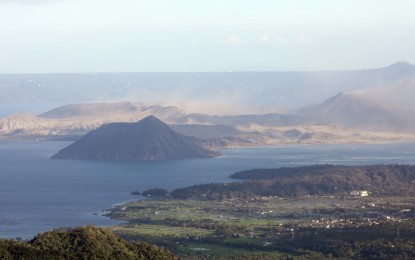MANILA – The Philippine Institute of Volcanology and Seismology (Phivolcs) on Friday night announced the lowering of Taal Volcano’s alert level status from level 3 (magmatic unrest) to level 2 (decreased unrest).
 (PNA file photo)
(PNA file photo)
“Following the phreatomagmatic eruption of the main crater on July 1, and 19 weak phreatomagmatic bursts caused by the interaction of magma and water until July 9, there has been a cessation of eruptive activity at Taal Volcano,” it said in an advisory.
Volcanic unrest has since been characterized by renewed seismic activity, generally declining volcanic gas emission, very slight ground deformation, and positive microgravity anomalies.
Since July 1, Phivolcs has recorded 1,195 volcanic earthquakes caused by the movement or eruption of magma from the volcano. Their magnitudes ranged from 1.8 to 4.6.
Most of the earthquakes occurred beneath the main crater and the northeastern sector of the Taal Volcano Island (TVI), indicating the migration of shallow degassed magma, volcanic gas, and/or hydrothermal fluids beneath these areas.
Sulfur dioxide (SO2) emission averaged 12,161 tonnes per day in the first week of July, with the highest emission of 22,628 tonnes per day recorded on July 4.
The average SO2 declined to 4,763 tonnes per day between July 8 and July 22.
“The decrease in degassing activity reflects the diminishing volumes of accumulated volcanic gas beneath TVI, as well as the ‘scrubbing’ effects of rainfall-fed water recharge into Taal’s hydrothermal system,” Phivolcs said.
Activity in the main crater has also been more often characterized by the generation of moderate steam-laden plumes and periodic but generally less vigorous lake upwelling, consistent with decreased magmatic degassing.
Despite lowering the volcano’s alert level status, Phivolcs said there remains an eruption threat.
Sudden steam-driven or phreatic explosions, volcanic earthquakes, ashfall, and lethal accumulations or expulsions of volcanic gas can occur and threaten areas within the TVI and along its coast.
Entry into the TVI, Taal’s permanent danger zone, must be strictly prohibited.
Phivolcs also advised local government units to assess previously evacuated areas within the 7-km. radius for damage and road accessibility, and strengthen preparedness, contingency, and communication measures in case of renewed unrest.

Leave A Comment